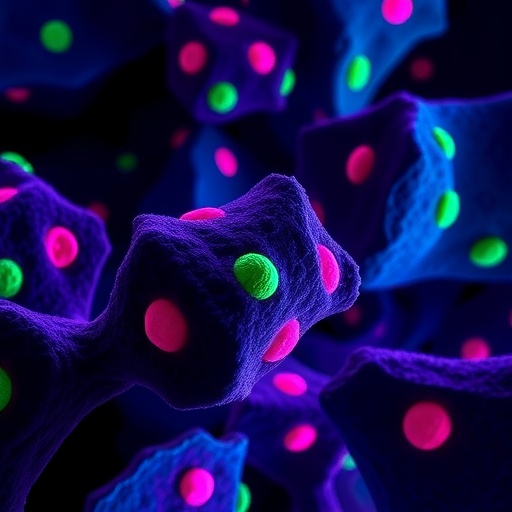In a groundbreaking development that could redefine oncological therapeutics, researchers at Wake Forest University School of Medicine have unveiled a novel strategy to eradicate cancer cells by incapacitating their internal waste management system. This approach targets the intrinsic vulnerability of cancer cells arising from their heightened production of reactive oxygen species, particularly hydrogen peroxide. Elevated hydrogen peroxide levels pose an oxidative threat, potentially lethal to the very cells that generate them. Under normal circumstances, malignant cells mitigate this oxidative stress by leveraging a mitochondrial protein known as peroxiredoxin-3 (PRX3), which functions as an intracellular detoxifying agent, neutralizing and decomposing hydrogen peroxide before its accumulation reaches cytotoxic concentrations.
The innovative tactic devised by the Wake Forest team hinges on selectively inhibiting PRX3, thereby disrupting the cell’s antioxidative defense mechanism and triggering an intracellular buildup of toxic hydrogen peroxide. This method exploits the cancer cells’ altered redox balance and metabolic flux, effectively pushing them beyond their oxidative stress threshold and inducing cell death. Published in Science Advances, the research details how disabling this mitochondrial cleanup protein serves as a molecular “kill switch,” selectively targeting tumoral cells while sparing normal cells that maintain a lower baseline production of reactive oxygen species.
Central to this discovery is the natural molecule thiostrepton, a complex compound previously recognized for its anticancer potential but limited in clinical applicability due to its bulky structure and poor solubility. The investigative team, including experts in biochemistry and medicinal chemistry, systematically deconstructed thiostrepton into smaller fragments to isolate the minimal pharmacophore responsible for PRX3 inhibition. This meticulous structural dissection led to the identification of WF-242, a significantly reduced molecular fragment exhibiting potent anticancer activity akin to the parent compound but with improved drug-like characteristics, particularly solubility and specificity.
The significance of WF-242 lies not only in its efficacy but also in its diminished off-target effects, a critical consideration in drug development. Whereas intact thiostrepton interacts broadly with cellular components, often eliciting undesirable side effects, WF-242’s reduced complexity translates to increased specificity for PRX3, enhancing therapeutic precision and potentially mitigating cytotoxicity in non-cancerous tissue. This refined selectivity emerges from the fragment’s ability to covalently bind to PRX3, a biochemical interaction elucidated via high-resolution X-ray crystallography, which provided invaluable insights into the molecular interface between the inhibitor and its target protein.
This structural elucidation empowers rational drug design, facilitating the fine-tuning of chemical properties to optimize stability and bioavailability—an essential step toward clinical viability. Current efforts focus on enhancing WF-242’s pharmacokinetic profile to render it suitable for intravenous administration, thereby expanding its therapeutic reach beyond localized applications such as direct lung delivery currently under exploration for mesothelioma treatment. This expansion holds promise for addressing metastatic and systemic malignancies, including ovarian, lung, prostate, brain, and hematologic cancers, which demonstrated susceptibility to PRX3 inhibition in cell-based assays.
The strategic elevation of oxidative stress in tumors marks a paradigm shift from traditional antioxidant-centric cancer therapies. Instead of mitigating oxidative damage, this approach leverages the inherently precarious redox equilibrium within cancer cells, deliberately amplifying oxidative stress to cytotoxic levels. Given that cancer cells operate near the brink of oxidative tolerance due to their hypermetabolic state, they are uniquely predisposed to this mode of intervention. This therapeutic exploitation of tumor biology underscores the precision and rationality of targeted cancer treatment modalities poised to improve clinical outcomes.
Mesothelioma, a notoriously aggressive malignancy with limited systemic treatment options and poor prognostic outlooks, serves as a key application target for this technology. While thiostrepton’s application has been constrained to localized lung delivery, WF-242’s favorable physicochemical properties open avenues for broader systemic therapies. The molecule’s ability to circumvent solubility and delivery challenges could transform the management of this devastating disease by providing a novel class of chemotherapeutic agents capable of intravenous administration.
The development trajectory of WF-242 embodies the quintessential pathway from natural product derivatization to precision pharmacology. This process illustrates how fundamental biochemical insights combined with advanced structural techniques and medicinal chemistry can yield transformative therapeutic candidates. The ongoing refinement and preclinical evaluation phases are critical milestones preceding human clinical trials, typically requiring several years of meticulous research and optimization to ensure safety, efficacy, and regulatory compliance.
Funding for this pioneering endeavor has been provided by the Wake Forest Innovations Catalyst Fund, Atrium Health Wake Forest Baptist Comprehensive Cancer Center, and the Center for Redox Biology and Medicine. Their support underscores the imperative of investing in innovative redox biology approaches to surmount longstanding challenges in cancer management. Should clinical translation prove successful, this research portends a new era in cancer treatment, where manipulation of intracellular oxidative environments becomes a frontline strategy in combating diverse malignancies.
The discovery also highlights the interdisciplinary collaboration essential to contemporary drug development, integrating biochemistry, structural biology, pharmacology, and clinical oncology. The insights gained from visualizing drug-protein interactions provide a roadmap for subsequent medicinal chemistry efforts aimed at enhancing drug specificity and minimizing off-target toxicities. This iterative process epitomizes the modern drug discovery paradigm, driven by mechanistic understanding and technological innovation.
Ultimately, this research at Wake Forest University School of Medicine epitomizes the potential of targeted redox modulation in oncology. It develops a sophisticated molecular weapon that can disable cancer cells’ defenses, induce cytotoxic oxidative stress, and overcome the limitations of previous treatment modalities. As clinical validation progresses, WF-242 and its derivatives may emerge as vital components in the arsenal against cancers that have long evaded effective systemic therapies.
Subject of Research: Targeted inhibition of peroxiredoxin-3 (PRX3) to induce oxidative stress and kill cancer cells.
Article Title: Mechanism-based peroxiredoxin 3 inhibitors exploit a covalent warhead for cancer therapy
News Publication Date: 4-Nov-2025
Web References:
https://school.wakehealth.edu/
https://www.science.org/doi/10.1126/sciadv.ady4492
http://dx.doi.org/10.1126/sciadv.ady4492
Keywords: Cancer, Cancer treatments, Biochemistry, Structural analysis, Cancer cells, Mesothelioma, Drug development
Tags: inhibiting peroxiredoxin-3 functionintracellular hydrogen peroxide buildupmitochondrial protein PRX3molecular kill switch for tumorsnovel oncological therapeuticsoxidative stress in cancer cellsreactive oxygen species in oncologyredox balance in cancerScience Advances cancer researchselective targeting of cancer cellstumor cell eradication strategyWake Forest University cancer therapy





